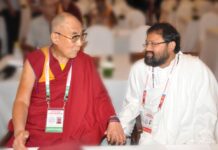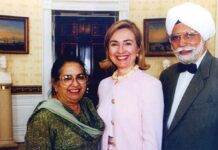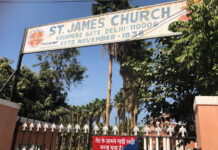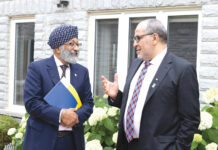By Balwant Sanghera
VANCOUVER: Punjabis are very adventurous and never shy away from a challenge. Travelling thousands of miles from their homeland to a completely strange and often hostile environment has never deterred them. Countries like Canada have always been very attractive to them in order to better themselves especially in the economic sense.
With this objective in mind, a number of brave souls from the Punjab are reported to have arrived in Golden, BC, a small community about 800 kilometers east of Vancouver, in mid 1880s. They are reported to come through the United States via the Columbia River. There, they found work in a sawmill. Unfortunately, the saw mill burnt down in 1927. Some of the Punjabis went back to the US whereas a large number of them came to Vancouver, B.C.
In 1897, Queen Victoria celebrated her diamond jubilee. She invited some Sikh soldiers to London to participate in the celebration. After the celebration, they decided to visit Canada before returning to India. They were very impressed with Canada’s beauty, resources and job opportunities. Consequently, some of them decided to return to Canada in 1903/4. They were followed by many others. Thus, by 1907 there were close to 5,000 Punjabis living in the Vancouver area.
Interestingly, the Punjabis at that time included Sikhs, Hindus and Muslims. They faced a lot of discrimination, racism, hatred and violence. Consequently, they decided to face these issues collectively and formed Khalsa Diwan Society (KDS) on July22, 1906. KDS became a strong advocate for the community. Under its auspices these pioneers built the first Gurdwara in 1908 that would serve as a base for the community. Three years later, another Gurdwara was built in Abbotsford in 1911 to serve the Fraser Valley Sikhs. This Gurdwara was declared a National Heritage Site in 2002 by then Canadian Prime Minister Jean Chretien.
The growing curse of racism reached a very high pitch and brought in the Asian Exclusion Act by the end of 1907. By virtue of this act, immigration from India, China and Japan was stopped. Thus, the numbers for our community dwindled fast. It has been reported that by the end of 2009 there were around 900 persons of Indian heritage living in the Metro Vancouver area.
To rub salt in our community’s wounds, the government of the time took away the right of citizenship from our ancestors to which they were entitled as British subjects. Furthermore, they also passed the Continuous Journey Act. It prevented people from India travelling to Canada without stopping anywhere along the way which was impossible at that time.

This precipitated the Komagata Maru tragedy in 1914 when a Japanese ship by this name was leased by Hong Kong businessman Gurdit Singh. He brought in 376 passengers to unsuccessfully challenge the Continuous Journey Act. Unfortunately, only 20 or so passengers on this ship, who had some prior status in Canada, were allowed to land and the remaining 356 were forced to go back to India at gun point after anxiously waiting for two months (May 23 to July23, 1914) in Vancouver harbour. To its credit, the current Liberal government lead by Prime Minister Justin Trudeau apologized on May 18,2016 in Canada’s Parliament to the South Asian community for this tragedy.
The Indian community’s woes here were compounded further by people like John Hopkinson. Hopkinson was a ruthless intelligence agent who hated the Indian community with a passion. He was the son of a British military officer and an Indian woman. Hopkinson was born and raised in Jalandhar Cantonment. He was well versed not only in intelligence but also could speak a number of languages including Hindi, Urdu and Punjabi in addition to being fluent in English. Hopkinson was sent by the British Indian imperialist government to keep an eye on the Gadarites and the Indian community here.
His main mission was to make things miserable for the Indian community here. Hopkinson used every trick to divide and destroy our community and make things extremely difficult for our ancestors here. He manipulated the murder of two prominent Sikh leaders at the KDS Gurdwara in Vancouver. Hopkinson began to intimidate others including Bhai Mewa Singh, a simple honest and devoted Sikh from Lopoke village in Amritsar district. Mewa Singh refused to give in and ultimately decided to eliminate Hopkinson, a sworn enemy of the Indian community. Mewa Singh was hanged on January 11, 1915. He was considered a hero by the Indian community and still is. The entire community turned out to his funeral at Fraser Mills where he used to work.
Prominent local historian Sohan Singh Pooni, in his book Canada de Gadari Yodhey (Freedom Fighters of Canada), states that it was KDS Gurdwara that in addition to many activities of religious, cultural, social and political nature also did a lot for the promotion of Punjabi language and literature. On top of that, KDS Gurdwara became a great resource for the Gadar Movement of freedom fighters that came into existence in 1913. Finally, when India became independent in 1947, it gave a big boost to the Indian community living in Canada. Our right to vote was restored. Also, members of our community were able to attend post -secondary institutions and get into various professions and run their own businesses.
This gave our community’s business savvy individuals like Mayo Singh Kapoor Singh and many others in our community to start their businesses in forestry, mining and other areas. They were followed by people like Asa Singh Johal, Herb Doman, Sohan Singh Gill,Gurdit Singh Sanghera, Ranji Mattu, Jack Oppal and many others. The period from their arrival in Canada by our pioneers to 1947 is considered to be a hard struggle. However, things began to improve gradually for the Indian community here. More immigrants from India were coming in. The quota had been increased from 100 to 300 a year for the immigration from India. For the next few years our community underwent a slow and steady growth. It was a time to consolidate our gains and move forward.
Expo 1967 ,celebration of Canada’s centennial, was a memorable event. The federal government under Prime Minister Lester Pearson welcomed the world. It opened Canada’s doors for people around the globe. This brought in huge number of “visitors’ especially from Punjab in early late 1960s and early seventies . A number of them claimed refugee status and were allowed to stay. Most of these new immigrants from Punjab were fairly well educated This gave a huge boost to our community. Pearson’s successor Pierre Elliott Trudeau officially made Canada multicultural by bringing in the Multiculturalism Act in 1971.
From the early seventies to present our community has grown tremendously. The community got a big boost in 1986 when Moe Sihota, a young lawyer from Victoria suburb, was elected to the BC legislature under the banner of the New Democratic Party (NDP). Again, in 1991 when the NDP formed the government in British Columbia, Moe became the first Indo-Canadian to be elevated to the ministerial rank. He served as a minister in various portfolios and is still considered to be the best environment minister British Columbia province ever had.
Moe was followed by his friend Herb Dhaliwal who was elected to the Canadian Parliament under the Liberal Party banner. Herb was also the first Indo-Canadian to become a minster at the federal level in 1993. Then came Ujjal Dosnajh . Under the NDP banner, Ujjal was the first Indo Canadian to become leader of a mainstream political party (NDP) and then premier of British Columbia in February 2000. Since those days, our community has never looked back.
Today, having 20 Punjabi MPs in Ottawa and numerous MLAs in many provinces is a tribute to our community’s hard work, resilience and generosity. Our growing numbers have made Punjabi as the third most spoken language in Canada. Not only that, our community is now considered to be the most resourceful and powerful communities in Canada. Be it business, education, media, technology, sports or whatever, members of our community are on top. Indeed, this is the golden moment for Punjabis in particular and Indo-Canadians in general this country. (A community activist and retired school psychologist, Balwant Sanghera is based in Richmond, British Columbia)
READ ALSO: Canada’s Wanda McDonald explains why she became a Sikh
Facebook Comments








